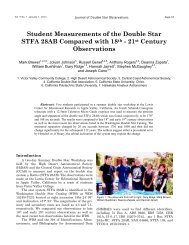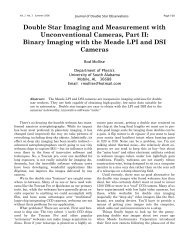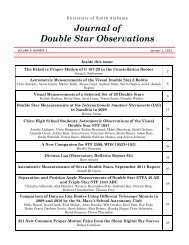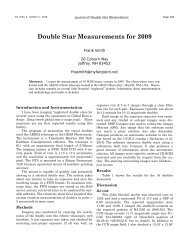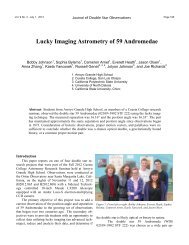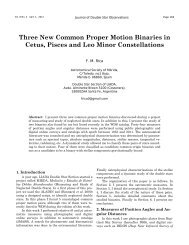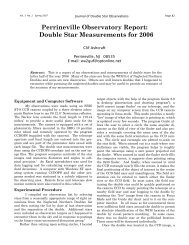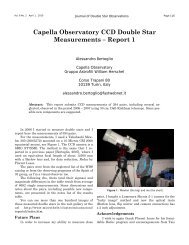Christian Mayer's Double Star Catalog of 1779 - JDSO.org
Christian Mayer's Double Star Catalog of 1779 - JDSO.org
Christian Mayer's Double Star Catalog of 1779 - JDSO.org
Create successful ePaper yourself
Turn your PDF publications into a flip-book with our unique Google optimized e-Paper software.
Vol. 3 No. 4 Fall 2007 Journal <strong>of</strong> <strong>Double</strong> <strong>Star</strong> Observations<br />
Page 152<br />
1781 version, the catalog included 80 double stars.<br />
The closest system was 5 epsilon Lyrae with a separation<br />
<strong>of</strong> 2.9 arc seconds. It gives us a good impression <strong>of</strong><br />
the quality <strong>of</strong> Mayer’s telescope. The minimum separation<br />
<strong>of</strong> a perfect 2.5 inch reflector is about 1.7”.<br />
William Herschel heard in <strong>1779</strong> about Mayer’s<br />
work and started his own observations <strong>of</strong> double stars.<br />
His intention was not to study the proper motion, he<br />
wanted to measure parallax (Herschel, 1782). Their<br />
method <strong>of</strong> operation in making their measurements<br />
was very different. With a mural quadrant, differences<br />
in declination were pick up directly, the differences<br />
in right ascension were measured with help <strong>of</strong><br />
an astronomical pendulum clock (Mayer, 1778). With<br />
a declination <strong>of</strong> 0 degree, a star moves 15 arc second<br />
in one time second. In this way measurements were<br />
done in Cartesian coordinates. In opposition to Mayer<br />
<strong>Christian</strong> Mayer’s <strong>Double</strong> <strong>Star</strong> <strong>Catalog</strong> <strong>of</strong> <strong>1779</strong><br />
Figure 2: Mayer’s observation notes from January 24 and 25 , 1776, photo: J. S. Schlimmer 2007<br />
Herschel measured the separation and the position<br />
angle directly in polar coordinates by comparing his<br />
observation with the placement <strong>of</strong> his lamp micrometer.<br />
In 1782 Herschel published his first double star<br />
catalog in the Philosophical Transactions.<br />
In Mayer’s catalog, <strong>of</strong>ten the stars had no name,<br />
but the coordinates for the year <strong>of</strong> his observations<br />
1777 and 1778 are described. Because the precession<br />
<strong>of</strong> the earth's axis, the coordinates are obsolete. For<br />
example, gamma Arietis has moved 12 arc minutes in<br />
right ascension and 1 degree in declination. The first<br />
step <strong>of</strong> my review <strong>of</strong> Mayer’s catalog was to calculate<br />
the current coordinates. With the, new coordinates<br />
many unnamed doubles could be identified.<br />
The second step <strong>of</strong> my review was to transform<br />
Mayer’s Cartesian coordinates into polar coordinates.<br />
Because the way a star moves in time depends on its



